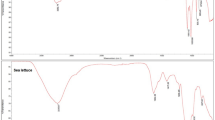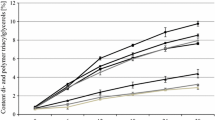Abstract
Different sources of DHA and/or n-3 (omega-3) rich oils, oil emulsions and microencapsulated (ME) powders were tested at two different concentrations with the aim of producing fortified pan bread. Three oils (S-algae, fish and flax), two emulsified algae oils (Emulsion-P and Emulsion-L) and two ME oils (ME-S algae and ME-C algae) were compared. The DHA and n-3 oils replaced part of the shortening in order to obtain 32 g slices enriched with 25 or 50 mg DHA, 35 or 70 mg total n-3 from fish oil and 90 or 180 mg linolenic from flax oil. Addition of oils did not significantly affect water absorption but reduced mix time whereas addition of the ME oils decreased both water absorption and mix time. Breads enriched with flax or ME-C oils had lower volume and higher density than the control, ME-S algae, Emulsion-P and Emulsion-L breads. All breads lost texture throughout 14 d storage, the major changes occurred after 3 d. The ME-S algae oil bread had the best softness after 14 d storage whereas breads produced from ME-S algae or ME-C algae oils had the poorest texture. Sensory evaluations indicated that the color of the ME-S algae oil fortified bread was significantly less preferred than the other loaves. After 6 d the control bread had higher acceptability compared with the rest of the breads enriched with high levels of DHA or omega-3 oils. The high-enriched fish oil bread was well accepted during the first days of storage but had the least preferred acceptability after 13 d. The best fortified breads were those supplemented with S-algae oil, Emulsion-P and Emulsion-L oils.

Similar content being viewed by others
Abbreviations
- DHA::
-
docosahexaenoic acid
- EPA::
-
eicosapentaenoic acid
- FAME::
-
fatty acid methyl esters
- GLC-FID::
-
gas liquid chromatography-flame ionization detector
- ME::
-
microencapsulated
- SSL::
-
sodium stearoyl-2-lactylate
References
Newton I, Snyder D (1997) Nutritional aspects of long chain omega-3 fatty acids and their use in bread enrichment. Cereal Foods World 42(3): 126–131.
Kumar Rudra P, Nair SSD, Leith JW, Garg ML (2001) Omega 3 polyunsaturated fatty acids and cardiac arrhythmias. In: Wildman REC (ed), Handbook of Nutraceuticals and Functional Foods, Chap. 20. Boca Raton, FL: CRC Press.
Leitzmann M, Stampfer M, Michaud D, Augustsson K, Colditz G, Willett W, Giovannucci E (2004) Dietary intake of n-3 and n-6 fatty acids and the risk of prostate cancer. American Journal Clinical Nutrition 80(1): 204–216.
Morris MC, Evans DA, Bienias JL, Tangney CC, Bennett DA, Wilson RS, Aggarwal N, Schneider J (2003) Consumption of Fish and n-3 Fatty Acids and Risk of Incident Alzheimer Disease. Archives of Neurology 60(7): 940–946.
Carper J (2000) Your Miracle Brain. New York, NY: Harper Collins Publishers.
Connor WE, Neuringer M, Reisbick S (1992) Essential fatty acids: The importance of n-3 fatty acids in the retina and brain. Nutrition Reviews 50(4) part II: 21–29.
Swortfiguer MJ (1971) Improving the shelf life of bread. Bakers Digest 46–50.
Birnbaum H (1977) Interaction of surfactants in bread making. Bakers Digest 51: 16.
Chung OK, Tsen CC (1975) Functional properties of surfactants in bread making. I. Roles of surfactants in relation to flour constituents in a dough system. Cereal Chem 52: 832.
Chung OK, Pomeranz Y, Finney KF, Shogren MD (1978) Surfactants as replacements for natural lipids in bread baked from defatted wheat flour. JAOCS 55: 635–641.
DeStefanis VA, Ponte JG, Chung FH, Ruzza NA (1977) Binding of crumb softeners and dough strengtheners during bread making. Cereal Chem 54: 13.
Serna Saldivar SO, Lopez Ahumada G, Ortega Ramirez R, Dominguez RA (1988) Effect of sodium stearoyl-2-lactylate on the rheological and baking properties of wheat bread fortified with defatted soybean and sesame meal. J Food Sci 53: 211–214.
Canty DJ (2001) Lecithin and Choline: New roles for old nutrients. In: Wildman REC (ed), Handbook of Nutraceuticals and Functional Foods, Chap. 26. Boca Raton, FL: CRC Press.
AACC (2000) Approved Methods of the AACC, 10th edn. St. Paul, MN: American Association of Cereal Chemists.
Anzaldúa-Morales A (1994) La Evaluación Sensorial de los Alimentos en la Teoría y la Práctica. Zaragoza, España: Editorial Acribia, S.A.
SAS Institute (1999) Stat View Reference, 3rd edn. Cary NC: SAS Publishing.
Urade R, Okamoto S, Yagi T, Noriyama T, Ogawa T, Kito M (2003) Functions of soy phosphatidylcholine in dough and bread supplemented with soy protein. J Food Sci 68: 1276– 1282.
Mettler E, Seibel W (1993) Effects of emulsifiers and hydrocolloids on whole wheat bread quality: a response surface methodology study. Cereal Chem 70(4): 373–377.
Joensson T, Toernaes H (1987) The effect of selected surfactants on bread crumb softness and its measurement. Cereal Foods World 32(7): 482–485.
John-Bjarne H, Grimsgaard S, Nielsen H, Nordoy A, Bonaa KH (1998) Effects of highly purified eicosapentaenoic acid and docosahexaenoic acid on fatty acid absorption, incorporation into serum phospholipids and postprandial triglyceridemia. Lipids 33(2): 131–138.
O´Shea M (2003) Health benefits of marine based omega 3 fatty acids. Cereal Foods World 48(5): 236–237.
Acknowledgments
This research was partially supported by grant CAT-005 from the ITESM-Campus Monterrey, Mexico.
Author information
Authors and Affiliations
Corresponding author
Rights and permissions
About this article
Cite this article
SERNA-SALDIVAR, S.O., ZORRILLA, R., DE LA PARRA, C. et al. Effect of DHA Containing Oils and Powders on Baking Performance and Quality of White Pan Bread. Plant Foods Hum Nutr 61, 121–129 (2006). https://doi.org/10.1007/s11130-006-0009-5
Published:
Issue Date:
DOI: https://doi.org/10.1007/s11130-006-0009-5




